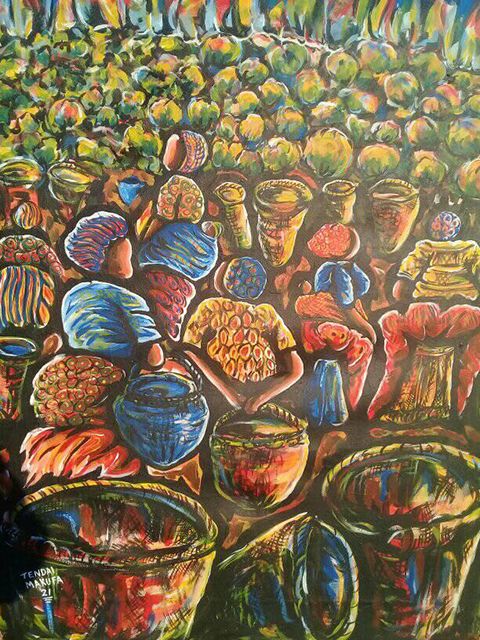Tendai Makufa: Waiting for Bumper Harvest
We have a new painting from South African aritst Tendai Makufa who has created Waiting for Bumper Harvest using acrylic decorative paint on canvas which is 65 x 80cm.
Tendai Makufa, like Bernard Takawira was born in Zimbabwe - he grew up in a small village near Masvingo, close to the Mozambique border later moving to live in South Africa.
Tendai paints his people at work in the fields tending the crops that their survival depends on.
When looking at a Tendai Makufa painting I am immediately drawn to the harmony brought about by the repetition of shapes and colours that naturally occur when humans and nature blend into one: when humans are part of nature.

I think there are four essential elements to a Tendai Makufa painting:
Narrative
The composition of the painting tells a story in a genre style. The figures in the painting are not arbitrary but essential features of the culture that the painting focuses on; their history, their rhythm of life, centres on the production of crops and a bumper harvest is a time for celebration. The anticipation of this crop is palpable in the stance of the women who in spite of no detailed facial features portray an expectation of hope. The closer you look into the painting the more figures you will see as Tendai has blended them expertly into the scene through his masterly juxtaposition of shape and colour. The perpective taken leads the viewer from the large empty baskets prepared to receive the harvest, to the waiting women standing expectantly in front of the ripening harvest which dominates the background. The women are placed in the middle ground central to the composition because this is their story, their lives.
Colour
A significant feature and appeal of a Makufa painting is colour. Makufa lights up the world with his bold and confident use of the primary colours (red, yellow, blue) supported by the secondary colour - green - the colour of life and growth. Blue and red are used to distinguish the women from the crop, green for the natural world of the plants and yellow for the light and warm from the sun. Nothing is accidental - every patch of colour has a purpose and a place in the overall composition and story.
Shape
The basic shape used is the circle - there are few straight lines to be seen. But then staight lines aren't part of the natural world. Straight lines were invented by architects and engineers and we won't question here why - but most likely becausse it is easier and cheaper to build with straight lines. But Mother Nature knows how to build with curves and they abound in a Makufa painting; the curved shape of the bodies, the roundness of the ripening crop, the annular shape of the baskets.
Pattern
The overall impression one gets is of an intricate pattern like a quilt. Each significant feature - the crop, the women, the baskets - are formed by shape and colour which meld to form a harmonious scene.
The rhythm is quiet and slow but there is an expectation that this scene is about to burst forth in song and activity as the crop comes to maturity.
Follow this link to a previous AnArt4Life post on Tendai Makufa.
© Thank you to Tendai Makufa who kindly gave permission for the images of his work to be shared on AnArt4Life.
Credit
1. facebook.com/tendai.makufa
